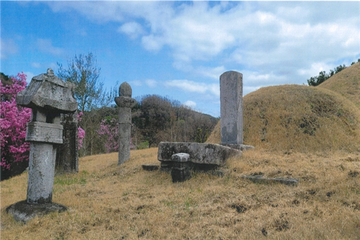창주 이성길 묘
| 창주 이성길 묘 Tomb of Yi Seong-gil |
|
| 대표명칭 | 창주 이성길 묘 |
|---|---|
| 영문명칭 | Tomb of Yi Seong-gil |
| 지정(등록) 종목 | 포천시 향토유적 제54호 |
해설문
국문
조선후기 이성길(1562~1621)은 1592년 임진왜란이 발발하자 유도대장 이양원(李陽元)의 종사관으로 참전하였고, 의병장 정문부(鄭文孚)와 함께 의병활동에 적극 동참하여 공을 세웠다.
1613년(광해군 5) 동지사(冬至使)로 명(明)나라에 다녀왔으며, 관직은 병조참판에까지 이르렀으나, 1621년(광해군 13) 명나라에 사신으로 다녀오다가 금교역(金郊驛)에서 60세로 병사하여 포천에 묻혔으며, 이는 이후 고성이씨가 포천에 세거하면서 대대로 활약하는 계기가 되었다.
이성길은 문무를 겸한 관료로 다수의 글과 회화 작품을 남겼다. 중국 진중에서 그린 「쌍포승첩도(雙浦勝捷圖)」와 명나라에 사신으로 다녀오면서 그렸다는 「무이구곡도(武夷九曲圖)」 등이 전해진다.
이성길의 묘 주변 석물은 17세기에 조성된 것으로, 묘소 앞에는 비와 상석, 장명등, 향로석, 망주석 등이 있으며, 묘갈에는 신후재(申厚載, 1636~1699)가 지은 묘지명이 남아있다.
영문
Tomb of Yi Seong-gil
This is the tomb of Yi Seong-gil (1562-1621), a civil official and painter of the Joseon period (1392-1910).
Yi passed the state examination in 1589 and began his service as a civil official. In 1592, when Japan invaded Korea, Yi joined the war as an army commander and also actively participated in the civilian army’s campaigns. Later, he served several official posts and was promoted to the position of second minister of the Ministry of War. In 1613 and 1621, Yi visited Ming China as an official envoy, but while returning from his second trip he died of illness at Geumgyo Station (today’s Geumcheon area in Hwanghae-do Province, North Korea). As Yi’s tomb was built here in Pocheon, his descendants from the Goseong Yi Clan eventually settled in this area.
Yi Seong-gil did not only excel in civil and military service but was also a skillful artist and left a large number of paintings. Some of his most famous works are Victory at Ssangpo Port depicting a victorious battle that took place in Hamgyeong-do Province in 1592, and Nine-bend Stream of Mount Wuyi, which he painted in China.
The tomb’s stone sculptures were made in the 17th century and include a tombstone, table, lantern, incense table, and pillar.
영문 해설 내용
조선시대의 문신이자 화가인 이성길(1562-1621)의 묘소이다.
이성길은 1589년 과거에 급제하여 관직에 올랐다. 1592년 임진왜란이 일어나자 종사관으로 참전하였다가, 의병활동에도 적극 동참하여 적을 물리쳤다. 이후 병조참판 등 여러 요직을 역임하였으며, 1613년과 1621년에는 사신으로 명나라에 다녀오기도 하였다. 1621년 돌아오는 길에 금교역(지금의 황해도 금천 지역)에서 병사하였다. 이후 포천에 묘소가 조성되었고, 그의 후손인 고성이씨가 포천에 세거하게 되었다.
이성길은 문무를 겸비하였을 뿐만 아니라, 그림에도 재능이 있어 다수의 작품을 남겼다. 특히 임진왜란 당시 함경도 쌍포에서 대승한 것을 그린 「쌍포승첩도」와 중국 무이산의 절경을 그린 「무이구곡도」 등이 유명하다.
묘 주변의 석물은 17세기에 조성된 것으로, 묘비, 상석, 장명등, 향로석, 망주석 등이 있다.
